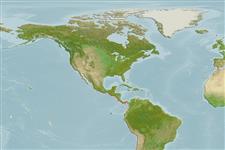Environment: milieu / climate zone / depth range / distribution range
Ökologie
seewasser; süßwasser; brackwasser demersal. Tropical; 25°C - 30°C (Ref. 36880)
Eastern Central Pacific: rivers near Tepic, Mexico, to the Rio Copalita near Puerto Angel in the south of Mexico, Pacific drainage. From the Río Pozo Salado, Playa Naranjo to the Río Jicote, near Loma, Costa Rica (Ref. 36880).
Size / Gewicht / Alter
Maturity: Lm ? range ? - ? cm
Max length : 28.0 cm SL Männchen/unbestimmt; (Ref. 50190)
Inhabit rivers and creeks of low to moderate current velocity. A benthic piscivore (Ref. 36880).
Life cycle and mating behavior
Maturities | Fortpflanzung | Spawnings | Egg(s) | Fecundities | Larven
Hoese, D.F., 1995. Eleotridae. Durmientes. p. 1062-1064. In W. Fischer, F. Krupp, W. Schneider, C. Sommer, K.E. Carpenter and V. Niem (eds.) Guia FAO para Identification de Especies para lo Fines de la Pesca. Pacifico Centro-Oriental. 3 Vols. FAO, Rome. (Ref. 9296)
IUCN Rote Liste Status (Ref. 130435)
Bedrohung für Menschen
Harmless
Nutzung durch Menschen
Tools
Zusatzinformationen
Download XML
Internet Quellen
Estimates based on models
Preferred temperature (Ref.
123201): 26.9 - 29.2, mean 28.5 °C (based on 55 cells).
Phylogenetic diversity index (Ref.
82804): PD
50 = 0.6250 [Uniqueness, from 0.5 = low to 2.0 = high].
Bayesian length-weight: a=0.00537 (0.00260 - 0.01111), b=3.09 (2.90 - 3.28), in cm total length, based on LWR estimates for this (Sub)family-body shape (Ref.
93245).
Trophic level (Ref.
69278): 3.5 ±0.6 se; based on size and trophs of closest relatives
Widerstandsfähigkeit (Ref.
120179): mittel, Verdopplung der Population dauert 1,4 - 4,4 Jahre. (Preliminary K or Fecundity.).
Fishing Vulnerability (Ref.
59153): Low vulnerability (24 of 100).
